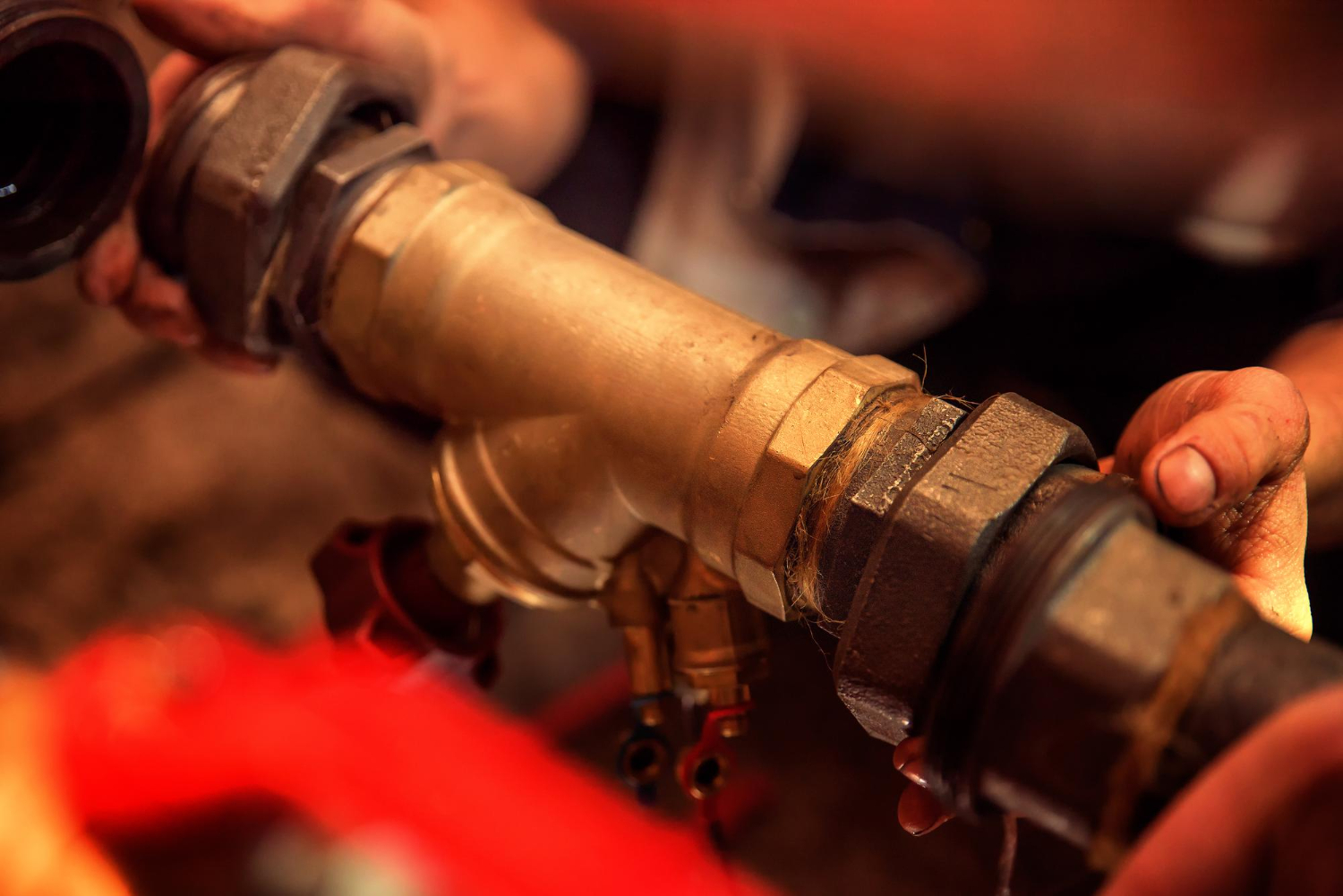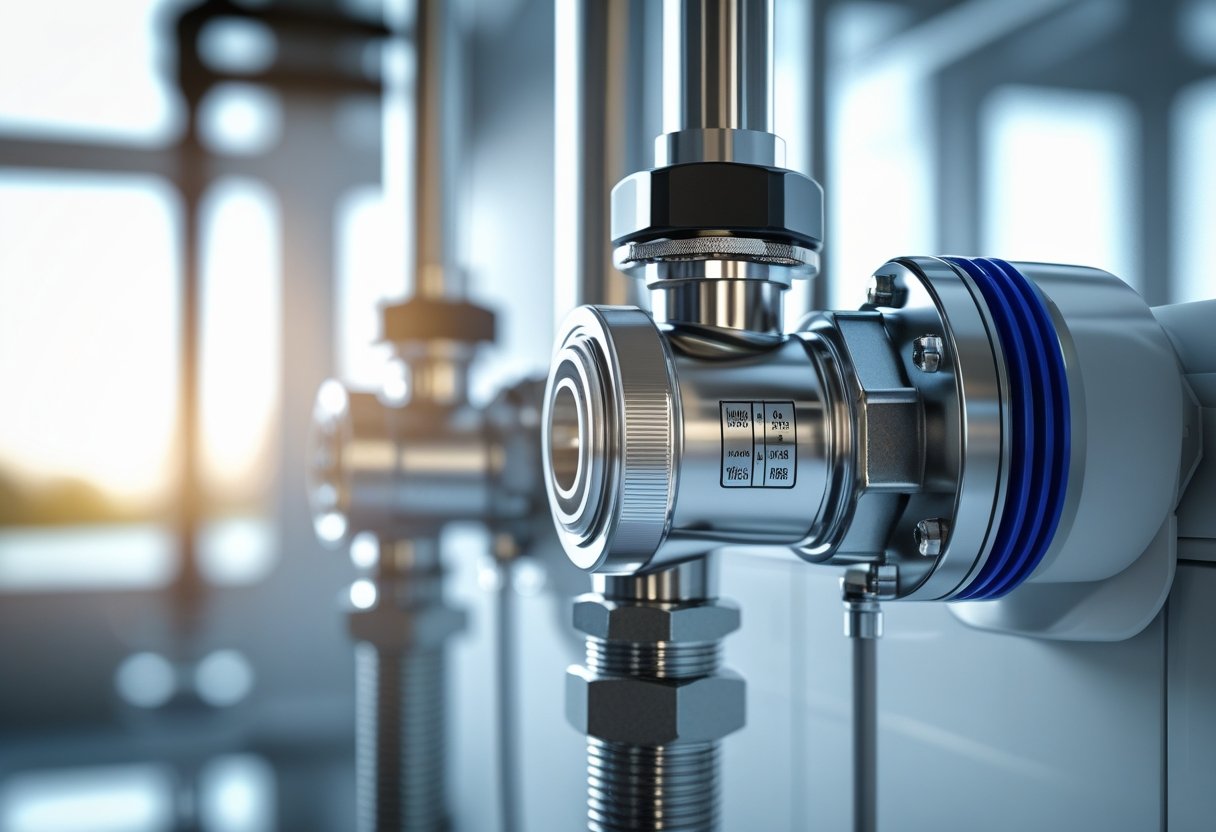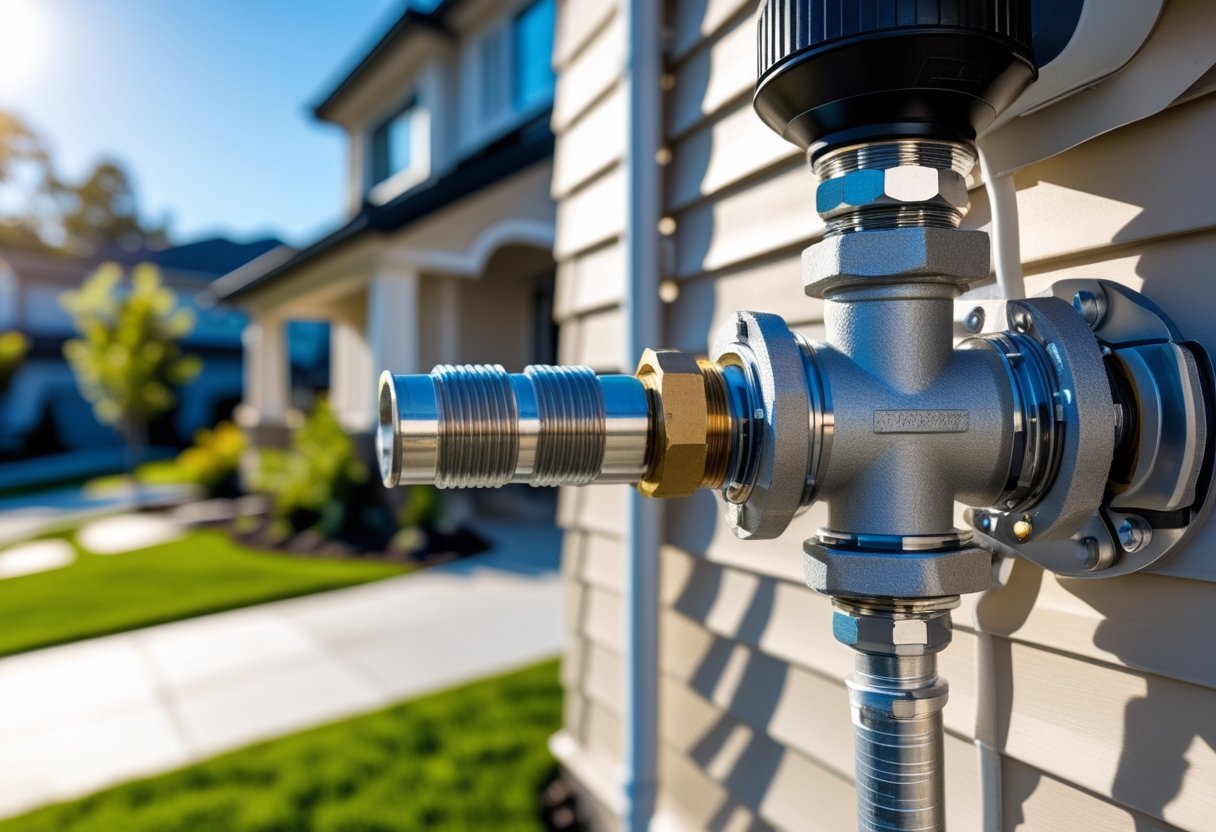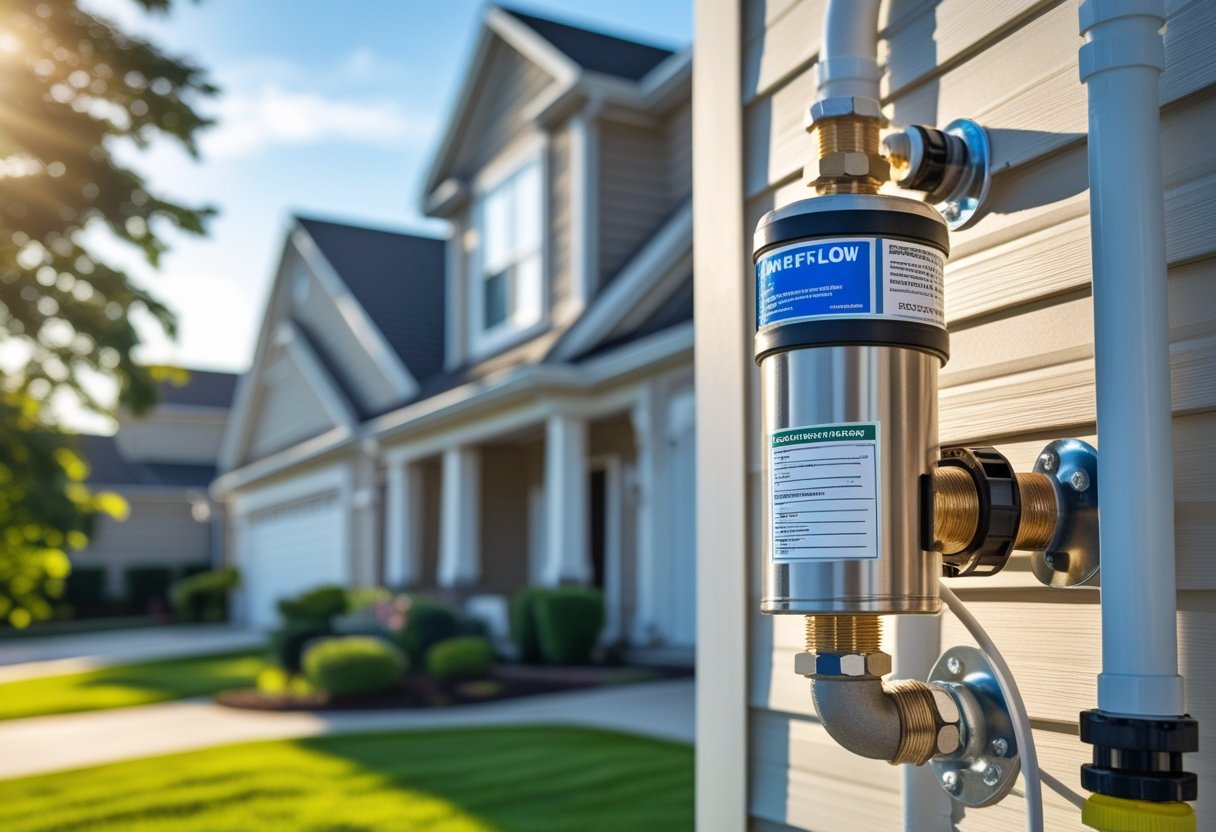Backflow systems protect drinking water by preventing contaminated water from flowing backward into clean water supplies. When these systems fail or need testing, property owners often face urgent deadlines to stay compliant with local regulations.
Same day backflow testing services can complete required inspections and provide certification within hours of scheduling, helping property owners meet emergency deadlines or urgent compliance requirements. Many companies now offer expedited testing with orders placed before noon on weekdays.
Understanding the costs, timing, and preparation steps helps property owners get their backflow systems tested quickly without delays or compliance issues.
In this article, you’ll learn how to schedule same day backflow testing to stay compliant and avoid fines or service interruptions.
Below, we’ll walk through each important aspect.
- Why same day backflow testing matters
- What's included in same day backflow testing
- Cost, timing, and when emergency backflow testing applies
- Who can test and what DIY isn't allowed
- Booking today and getting ready in minutes
Keep reading! These rapid testing services include full device inspection, immediate repairs when possible, and fast certification filing.
Why same day backflow testing matters
Quick backflow testing prevents water contamination and helps property owners avoid costly penalties. Understanding backflow events and recognizing warning signs allows for immediate action when water safety is at risk.
Avoid fines and shutoffs with a same day backflow check
Water utilities require annual backflow testing to protect public health. Missing these deadlines can result in hefty fines and water service disconnection.
Most cities impose penalties ranging from $100 to $500 for late testing. Some municipalities charge daily fees until compliance is restored.
Common penalty structures include:
- Initial late fee: $100-$200
- Daily penalties: $25-$50 per day
- Reconnection fees: $150-$300
- Administrative costs: $50-$100
Water shutoffs create serious problems for businesses and residents. Restaurants cannot operate without water service. Medical facilities face safety violations.
Same day testing prevents these disruptions. Certified technicians can complete inspections within hours of scheduling. This rapid response keeps water flowing and avoids expensive downtime.
Property managers often schedule emergency testing when they discover expired certifications. Quick action protects tenants and maintains building operations.
What a backflow event is and why speed protects water quality
Backflow occurs when contaminated water flows backward into clean water supplies. This reversal happens when water pressure drops suddenly in the main supply lines.
Contaminated water can carry harmful bacteria, chemicals, and waste products. These substances pose serious health risks to anyone drinking the affected water.
Fire department operations often cause pressure drops. When firefighters use large amounts of water quickly, it creates suction in nearby pipes.
Water main breaks also trigger backflow events. Construction work and equipment failures can damage supply lines without warning.
Speed matters because:
- Contamination spreads rapidly through pipe networks
- Health risks increase with exposure time
- Early detection prevents widespread illness
- Quick testing identifies failed prevention devices
Same day testing catches problems before contamination reaches multiple users. Technicians can isolate affected areas and begin repairs immediately.
Two types of backflow at a glance: backsiphonage and backpressure
Backsiphonage happens when water pressure drops in supply lines. This creates suction that pulls contaminated water backward through pipes.
Common causes include water main breaks, heavy water usage, and pump failures. The vacuum effect draws water from pools, irrigation systems, and industrial equipment.
Backpressure occurs when downstream pressure exceeds supply pressure. Pumps, boilers, and elevated tanks can create this reverse flow condition.
Type
Cause
Example
Backsiphonage
Pressure drop
Fire department usage
Backpressure
Pressure increase
Boiler system malfunction
Both types require different prevention devices. Technicians must test specific components based on the backflow risk present.
Same day testing identifies which type of backflow is occurring. This allows for targeted repairs and proper device installation.
Signs of a backflow issue that call for urgent testing
Water discoloration is the most obvious warning sign. Brown, yellow, or cloudy water indicates contamination has entered the supply system.
Strange tastes and odors also signal backflow problems. Chemical flavors, metallic tastes, or sewage smells require immediate attention.
Physical symptoms in building occupants include:
- Nausea and stomach pain
- Diarrhea or vomiting
- Skin irritation
- Eye burning or redness
Reduced water pressure throughout a building can indicate backflow device failure. When pressure drops suddenly, prevention systems may not function properly.
Visible contamination around backflow devices shows problems. Water stains, mineral deposits, or plant growth near equipment suggests leaks or malfunctions.
Same day testing confirms whether these signs indicate actual backflow events. Quick diagnosis prevents health emergencies and limits contamination spread.
Property owners should never ignore these warning signs. Delaying testing puts everyone at risk and may violate local health codes.
What's included in same day backflow testing
Same day backflow testing involves specific procedures to verify your device works properly. The process includes gauge testing with water shutoffs, immediate repairs if needed, and complete documentation filing.
Step-by-step gauge testing with shutoffs and readings
A certified technician starts by shutting off the water supply to your backflow device. This step lets them safely test each part without water pressure.
The technician connects test gauges to specific ports on your backflow assembly. These gauges measure pressure differences across the device's internal valves.
Check valve testing comes first. The technician opens and closes test valves while watching gauge readings. Proper readings show the check valves stop backward water flow.
Relief valve testing happens next. The technician tests if relief valves open at the right pressure levels. This prevents damage from excess pressure.
Each valve gets tested separately. The technician records pressure readings at different points during the test. These numbers prove whether each part works correctly.
The whole testing process takes about 15-30 minutes per device. Water stays off during testing but gets turned back on right after.
Pass or fail, on-the-spot repairs, and quick retests
Your backflow device either passes or fails the test based on gauge readings. Passing devices meet all safety standards and need no work.
Failed devices get immediate attention from the technician. Common problems include worn check valves or relief valves that don't open properly.
Minor repairs often happen on the spot. This includes:
- Cleaning debris from valves
- Adjusting valve springs
- Replacing small rubber parts
- Tightening loose connections
Major repairs might need new parts or complete valve replacement. Same day services often carry common replacement parts in their trucks.
After repairs, the technician retests your device immediately. This confirms the fixes worked and your device now passes inspection.
Quick retests save you time and money. You don't need to schedule another visit or wait days for results.
Certification, tagging, and filing with your water authority
Passing devices get official certification paperwork right away. The technician fills out test forms with all pressure readings and device details.
A metal tag goes on your backflow device showing the test date and results. This tag proves to inspectors that testing happened on schedule.
Required documentation includes:
- Device serial number and location
- Test pressure readings
- Technician certification number
- Pass or fail status
- Any repairs made
The technician files test results with your local water authority within a few days. Most areas require this filing to keep your water service active.
You get copies of all paperwork for your records. Keep these documents safe since you might need them for future inspections or insurance claims.
Same day backflow testing companies handle all filing requirements. This saves you from dealing with water department paperwork yourself.
Cost, timing, and when emergency backflow testing applies
Same day backflow testing costs more than regular appointments due to urgency fees and limited technician availability. Emergency situations require immediate testing when water contamination risks exist or when compliance deadlines cannot wait.
Backflow test cost basics and what changes the price
Standard backflow testing costs between $50 and $150 for residential properties. Commercial and industrial testing ranges from $200 to $700 per device.
Several factors affect the final price. The type of backflow device changes testing complexity and time needed. Larger devices require more detailed inspections.
Location matters for pricing. Indoor devices may cost more if access is difficult. Devices in mechanical rooms or above ceilings take longer to reach and test.
Property size influences total costs. Multiple devices on one property usually get bulk pricing. Single device visits cost more per unit than multi-device appointments.
Local regulations impact testing requirements. Some areas require more detailed documentation. This adds time and increases the final bill.
Failed tests create additional costs. Immediate repairs are required before retesting. The retest adds another service fee to the original testing cost.
After-hours or rush fees and how availability works
Emergency backflow testing adds $75 to $200 in rush fees to standard pricing. Same day service requests typically cost 50% to 100% more than scheduled appointments.
Most certified technicians work standard business hours. Emergency calls pull them from regular schedules or require overtime pay.
Weekend and holiday testing carries the highest premium rates. Few technicians offer these services. Those who do charge double or triple standard rates.
Water shutoffs required for testing create scheduling challenges. Property owners must coordinate with tenants or employees. Emergency situations may not allow proper notice.
Access requirements stay the same for emergency testing. Technicians still need safe access to devices. Indoor locations require unlocking doors and providing clear pathways.
Testing takes the same amount of time regardless of urgency. Most tests complete within one hour. Rush fees cover availability, not faster service.
Bundling multiple devices to keep the visit affordable
Properties with multiple backflow devices save money through bulk testing. Most companies offer reduced per-device rates for multi-unit appointments.
Standard pricing drops significantly with volume. Three or more devices often get 20% to 30% discounts. Large commercial properties may negotiate even better rates.
Single trip costs benefit both parties. Technicians reduce travel time between jobs. Property owners avoid multiple service call fees.
Scheduling all devices together works best for emergencies. One technician can test several units in sequence. This reduces total downtime and disruption.
Mixed device types still qualify for bundle pricing. Residential and commercial grade devices can be tested together. The technician brings equipment for all device sizes.
Payment processing becomes simpler with bundled services. One invoice covers all devices tested. This reduces paperwork and accounting work for property managers.
Who can test and what DIY isn't allowed
Most areas require state-certified backflow prevention technicians to perform official testing, while DIY approaches face legal restrictions. Property owners must verify technician credentials and follow specific testing schedules to maintain compliance.
Can you do backflow testing yourself? What most areas require
Property owners cannot legally perform their own backflow testing in most jurisdictions. State regulations require certified backflow prevention technicians to conduct official compliance tests.
Regular plumbers without specific backflow certification cannot perform these tests either. The certification process involves specialized training on backflow prevention devices and testing procedures.
Legal consequences exist for unauthorized testing:
- Fines from local water authorities
- Invalid compliance documentation
- Potential liability for contamination incidents
- Required re-testing by certified professionals
DIY testing attempts create serious risks. Improper testing procedures can miss critical failures that allow contaminated water to enter the drinking supply.
Only certified technicians can submit official compliance paperwork to local authorities. This documentation proves the backflow prevention system works correctly and meets safety standards.
According to the U.S. Environmental Protection Agency, all backflow assemblies must be tested and maintained by trained and certified professionals, with proper documentation kept on file for each inspection and repair.
How to verify certified backflow testers nearby
Property owners should confirm technician credentials before scheduling service. Most states maintain online databases of certified backflow prevention specialists.
Check these verification sources:
- State plumbing board websites
- Local water utility approved contractor lists
- Professional backflow testing association directories
- Better Business Bureau ratings and reviews
Ask technicians for their certification number and expiration date. Valid certifications require regular renewal and continuing education to stay current.
Request references from recent commercial and residential clients. Experienced certified backflow testers nearby should provide examples of similar properties they have serviced.
Compare pricing and service offerings from multiple certified professionals. Some specialize in both testing and repairs, which eliminates coordination between different contractors.
How often preventers need testing to stay compliant
Annual testing represents the most common requirement across different jurisdictions. Some high-risk commercial properties may need testing every six months.
Most jurisdictions require annual testing of backflow prevention assemblies, and additional testing immediately after installation, relocation, or repairs, according to the Tualatin Valley Water District.
Local water authorities set specific testing schedules based on property type and risk level. Residential properties typically follow annual schedules, while hospitals and industrial facilities face more frequent requirements.
Testing frequency by property type:
- Single-family homes: Annually
- Apartment complexes: Annually
- Restaurants: Annually or bi-annually
- Medical facilities: Every 6 months
- Industrial sites: Every 6 months
Property owners receive notices before testing deadlines approach. Missing deadlines can result in water service disconnection until compliance testing occurs.
Some areas allow grace periods of 30-60 days past due dates. However, late fees and penalties often apply during these extension periods.
Booking today and getting ready in minutes
Same day backflow testing requires quick scheduling and proper preparation to meet city deadlines. Most tests take 20-30 minutes when customers prepare their property correctly and choose certified technicians with calibrated equipment.
Clear access, shutoff windows, and how long the visit takes
Property owners need to clear all obstacles around backflow devices before technicians arrive. This includes removing plants, tools, or storage items within three feet of the assembly.
Access requirements:
- Clear 3-foot radius around device
- Remove locks from meter boxes
- Trim overgrown vegetation
- Ensure gate access is unlocked
Technicians need water shutoff windows of 20-30 minutes for most residential properties. Commercial buildings may require longer shutoffs depending on system complexity.
The testing process involves shutting off water supply, connecting test equipment to test ports, and checking pressure readings. Licensed technicians use calibrated gauges to measure differential pressure across check valves.
Most residential tests finish within 30 minutes. Fire line assemblies and irrigation systems may take slightly longer due to additional test points and larger pipe sizes.
Irrigation, fire line, and residential prep made simple
Residential preparation steps:
- Locate your backflow preventer near the water meter
- Clear debris from test ports and shut-off valves
- Check that test ports aren't capped or damaged
- Schedule during business hours for faster service
Irrigation system owners should turn off automatic timers 24 hours before testing. This prevents the system from activating during the test and affecting pressure readings.
Fire line assemblies require coordination with building management. Technicians need access to fire department connections and riser rooms. Some buildings need advance notice to disable alarm systems.
Commercial building requirements:
- Building access codes or key holder contact
- Fire alarm system notification
- Maintenance staff availability
- Alternative water supply planning
Need paperwork fast? Pacific Backflow can test, certify, and file today
Certified technicians submit test reports directly to city offices within 24 hours of completion. This eliminates paperwork delays and ensures compliance with municipal deadlines.
Same day service includes immediate report generation and electronic filing. Property owners receive copies of all documentation including test results and compliance certificates.
Report includes:
- Test pressure readings
- Device condition assessment
- Repair recommendations if needed
- City compliance verification
Licensed testers use digital reporting systems that connect directly to city databases. This speeds up the filing process and reduces errors from handwritten forms.
Emergency repairs get priority scheduling when devices fail testing. Technicians carry common replacement parts for quick fixes that restore compliance the same day.
Conclusion
Same day backflow testing provides property owners with fast solutions when time matters most. This service helps prevent contamination from entering clean water supplies quickly.
Professional technicians can complete testing and repairs within hours. They arrive with proper equipment and certifications to handle backflow issues correctly.
Most companies offer same day service for orders placed before noon on weekdays. This timing allows technicians to complete work during regular business hours.
Property managers and homeowners benefit from having reliable contact information for emergency situations. Quick response prevents water contamination from spreading to other areas.
Regular maintenance prevents most backflow problems from becoming emergencies. However, unexpected issues like pressure changes or equipment failures still occur.
Same day service costs more than standard appointments. The extra expense protects property value and ensures water safety compliance.
Licensed specialists understand local codes and testing requirements. They provide proper documentation needed for city inspections and regulatory compliance.
Emergency backflow services give property owners peace of mind. Water safety issues require immediate attention to prevent health risks and legal violations.
Schedule your same day backflow test now with a certified technician to avoid fines, shutoffs, or compliance delays.











